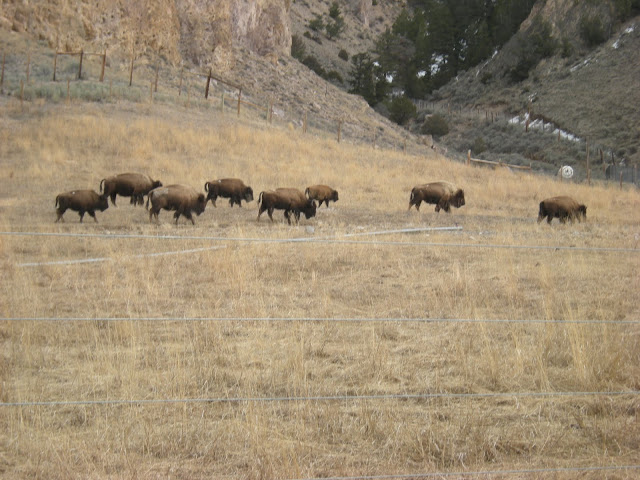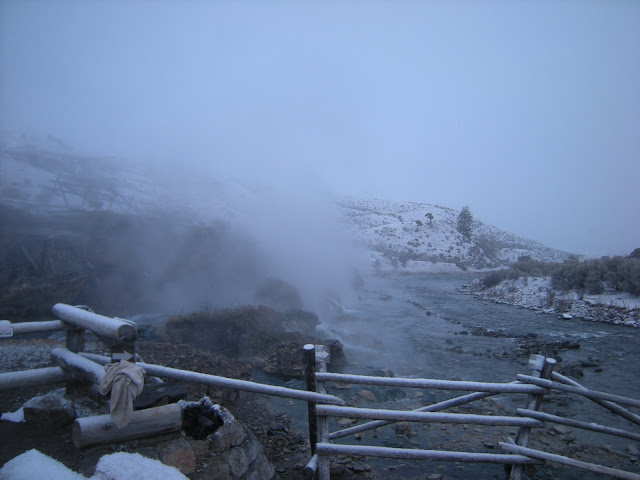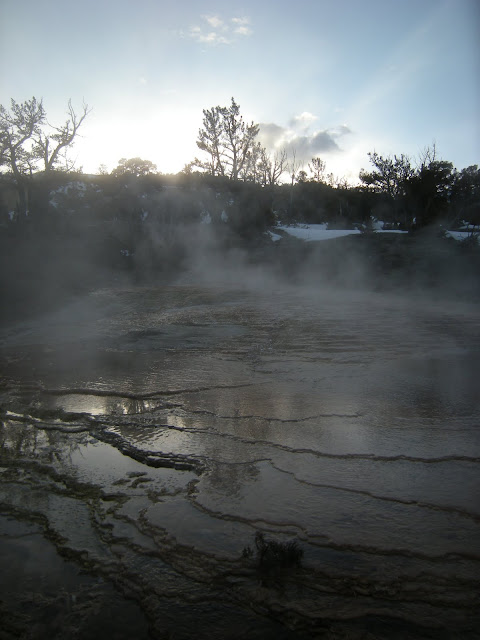 |
| Buffalo on the road in Yellowstone NP near Mammoth Hot Springs |
The first buffalo I saw in the “wild,” was standing in the road munching on some free native grasses put out by a local in Yellowstone Village, just outside of West Yellowstone Montana. I was sitting in the back of “cornflake,” the green and white Subaru used as a patrol car for the Buffalo Field Campaign. Patrols were different each day, but were centered around three main threats to the buffalo: hunters, highways and hazes. Despite there being fewer than 4000 Yellowstone bison, tags were issued for a hunt this year. Treaty rights also allow for three Native American tribes to hunt the buffalo. Buffalo Field Campaign recognizes the importance of the buffalo to the native peoples, and respects their right to hunt without documentation or interference from BFC. The state hunters, however, are often filmed by BFC volunteers, who also sometimes approach them and offer literature about the campaign, what's going on with the buffalo and why the buffalo population is nowhere near healthy enough to be hunted.
BFC also plays a vital role in protecting the buffalo as they cross the highways around Yellowstone NP. Outside of West Yellowstone, Highway 191 crosses the Madison River twice. Large semi-trucks and tourists frequent the highway, flying along at 70 miles and hour, the designated speed limit on a highway that crosses a major migratory zone, twice. The buffalo leave the park in hopes of finding areas of less snow where they can forage. They follow the river, where the shores are exposed and forage is much easier. However, once they reach the highway, the buffalo have nowhere to go. An inappropriately low bridge crosses the river, so the buffalo are forced to cross the highway instead of being able to go under the bridge. Buffalo Field Campaign volunteers keep a watchful eye along the highway. If there are buffalo crossing, they set up bright pink road signs that read "Buffalo On Road." I assisted in a few of these crossings and it was the only BFC activity in which I was allowed to safely speak my mind. As giant trucks and little cars flew by the signs at 70mph I screamed about their idiocy at the top of my lungs. My partner Andrew and another volunteer were unfortunate enough to witness what happens when people do not heed our warnings. A large group of buffalo were crossing the road at the same time but in a different place than a lone bull. Andrew and the other volunteer set up the signs for the large group and drove back to check on the bull, only to find that a local man had collided with the buffalo. His car was totaled and the buffalo was still alive, struggling to get up and get away. Eventually Montana Fish Wildlife and Parks showed up and shot the buffalo more than 7 times in the head until it was dead. They then proceeded to load it up and take it to the dump. The man refused medical treatment, but was arrested the next day under a warrant for another crime.
 | |
| The Madison River, looking West from the Northeast Bluffs towards Highway 191 |
While we were in West Yellowstone, we mostly participated in going on patrols. As an introduction to patrol, we headed out to Baker’s Hole campground just outside Yellowstone National Park for our “rookie rove.” I hadn’t been on skis since I was barely big enough to remember being yanked up the rope pull and pizza-ing my way down the bunny hill. So, with my cross country skis attached to my toes, I felt quite confident until just beyond the edge of the parking lot. As soon as I started to go downhill, I naively listened to my instinct to lean backwards. My tailbone was thankful for the many inches of powder there to break my fall. My clumsiness on skis was compounded by my desire to admire the gorgeous scenery of the low, snowy bluffs lining the willow-dotted shores of the slow slinky curves of the Madison River, all beneath the electric blue of that gigantic Montana sky.
 |
| Andrew on the edge of the Madison River, group of 25 or so buffalo across the river inside of Yellowstone NP |
We skied along her shores until we saw their silhouettes through the rising steam of the early spring morning. The giant, gentle beasts across the river distracted me so that I nearly fell down just standing still admiring their subtle, strong bodies, surrounded by the stark white snow.
 |
| Buffalo standing amongst the steam along the Madison River, inside Yellowstone NP. |
My own difficulties getting around on the snow felt infinitesimal in comparison to these 1500 pound buffalo spreading their weight over four relatively small hooves all winter long. At least I had a safe warm place to call home at night. In a few months, most of these buffalo won’t even have a muddy safe place to call home at any hour of the day. The state of Montana does not tolerate wild bison on its lands, supposedly to stop the transmission of a disease called brucellosis from the buffalo to the cattle. First off, there has been not one documented case of brucellosis transmission from a buffalo to a cattle. In fact, their only disease interaction was when the CATTLE gave the disease to the buffalo. Secondly, the cattle don’t come in to graze on PUBLIC lands until after the buffalo have almost always migrated back inside Yellowstone where there are no cows. As if that is not enough reason to believe the disease prevention is just a front, it is known that the disease is transmitted in the placenta, which the buffalo consume completely. The bacteria that causes the disease is killed within 24 hours by the UV rays from the sun anyway. So how, then, after 11 years of outrageous spending of tax dollars and harmful management actions, did a hard of cattle in Montana test positive for brucellosis? Perhaps because elk, who roam freely amongst the woods and the livestock of Montana and the Greater Yellowstone area, are also carriers of the disease. The genius of five agencies (the National Park Service, US Forest Service, USDA Animal Plant Health Inspection Services, Montana Fish Wildlife and Parks, and Montana’s Department of Livestock) created the Interagency Bison Management Plan, IBMP, to stop the spread of brucellosis. The report mentions nothing of the elk.
 |
| Elk grazing along the Gardner River inside Yellowstone NP |
Instead, the document authorizes “hazing”, a management action used to control the location of buffalo inside and outside of Yellowstone National Park. While in West Yellowstone, we were fortunate enough not to witness any hazing. However, we saw a haze almost every single day while in Gardiner at the North entrance to Yellowstone. A haze is when any of the agencies send people out on any combination of horses, ATVs, snowmobiles, and on special occasions, helicopters, to chase the buffalo. Here we have the public taxpayer’s dollars, paying government agencies to harass public wildlife on public lands. The cowboys from the Department of Livestock saddle up their horses to pointlessly chase buffalo, who have lost nearly half their body weight over winter and have been surviving the harshest conditions by eating dead grass they have to dig up from under feet of snow. I watched the DOL push 6 bulls from a nice grassy meadow in the Gallatin National Forest, into the hills above the meadow. By the next morning the bulls were back in the meadow; the DOL didn't bother them again while we were there.
 |
| Buffalo being hazed by DOL agents outside Gardiner, Montana |
Just another mile or so down the highway, and those bulls would be in the “drop dead zone” of Yankee Jim Canyon, just North of Gardiner Montana. Once the buffalo pass the 13 mile marker, they are “out of hazing range” and are shot and killed. Thankfully they’ve installed a cattle guard on the highway, on the opposite side of the river, where the road runs right along the cliff edge, where the buffalo are least likely to go if they decide to head into the canyon. Many of the actions these agencies are taking in regard to the buffalo are illogical and inconsistent. It was extremely frustrating to watch them haze buffalo who weren't even outside of the Yellowstone National Park boundary, while they left buffalo who were miles outside the boundary alone. Though they have the Interagency Bison Management Plan, their actions were inconsistent with what the document outlined, in addition to being inconsistent from day to day. BFC is no longer a direct action organization, so the main role volunteers play in hazes is to film. We had a few encounters with agents from the DOL and the Park Service, requesting that we stay 100 yards behind the haze, or out of sight of the buffalo if we were to go ahead of the hazing operation. At times this kept us entirely from getting any footage of the operation. However, our presence made at least some difference.
 | |
| Buffalo can "fly" when running; all four of their feet are off the ground at once. Taken during a haze outside Gardiner, Montana |
Most of the time, the hazes we saw were mellow and pushed the buffalo further inside the park boundary. Sometimes the buffalo would get agitated, though, and would start sparring or running or jump on each others backs. Injuries occur fairly often from hazing operations, especially when there is still snow to battle with, and mud in which the buffalo can easily lose footing and tweak limbs and fall in the panic that follows being chased by snowmobiles and helicopters. Hazes can result in capture operations as well. In Gardiner, we frequented the Stephen's Creek Facility, operated under the IBMP and located inside the Yellowstone National Park boundary. The facility was home to over 500 buffalo while we were there in March, and currently has over 600 buffalo in captivity. The park service has very conveniently located the facility in a small basin, protected on most sides by rolling hills that obscure it from view. From afar it looks like a giant cattle feedlot.
 |
| Stephen's Creek Facility, run by the National Park Service, on National Park land. Currently has over 600 buffalo in captivity |
No one is allowed within the "temporary closure area" for "public safety," that provides a little less than a mile buffer around the facility. The sign at the end of the road says "corral operations," and nothing else indicates what exactly is occurring on public lands that is unsafe for the public to be around.
 |
| These signs lined the road around the closure area. The closure of public land in a national park when there is no threat to their safety is illegal... |
Inside the facility, the buffalo are fed daily by a tractor that drops alfalfa hay for them to eat out of the mud and muck that occurs when you keep 500 half ton wild animals in an enclosed space for months at a time. The hay isn't very good for the buffalo as it is much richer than the food they are used to eating at this time of year. Although the issue of the buffalo is not truly about the disease brucellosis, I still feel compelled to bring up the point that the risk of disease transmission inside the facility must be tremendous is comparison to when they are roaming free. That risk is much higher this time of year, as mothers are giving birth to calves inside the facility, and the disease is transmitted in the afterbirth. Buffalo captured and brought into the facility are also subjected to all kinds of testing, drugs, and human interactions. There are multiple smaller facilities in the Gardiner Basin, one of which a volunteer and I explored from the other side of the 15 foot high chainlink barbed wire motion sensor camera equipped fence. What we saw was depressing to say the least. Most of the buffalo had at least a few small patches of missing fur and raw exposed skin.
 |
| Buffalo grazing inside the Corwin Springs Facility. Almost all of them have open wounds. |
 |
| Some of these buffalo have been in here for months and it shows in their exposed ribs and wounded raw flesh. |
My time in Gardiner taught me a lot about the complexity of the issue and allowed me to experience a wide range of emotions inherent in being around the buffalo. I have never seen an animal species where the individuals had such unique, expressive faces. I would see the buffalo as they grazed peacefully, as they sparred playfully, as they ran feverishly, and as they stood their ground and intently stared down the agents hazing them. The gentleness of their nature overwhelmed me. Even with these evil cowboys chasing the buffalo, screaming "go bull" at them they never once turned their great stature and strength against them. At most, they grew agitated with one another, or just stood and looked at the agents. The agents don't see the buffalo the way I do, the way that most people do. It was amazing to be in their presence. One day we were heading into Yellowstone to check on a big herd that had been hanging around deeper in the park. We reached the bridge that crosses the Gardner River and were greeted by a group of 9 or so on the other side of the bridge. The other volunteers suggested we just turn around, but I asked if we could just stay and see what they did. We pulled off the side of the road just inside the bridge and were rewarded by the group walking across the bridge and grazing around us. I took so many pictures and was in complete awe as they came within a few feet of the car. I could hear them breathing and the click of their hooves on the pavement, the gentle chewing of grass. Each one had a personality, a wise old worn buffalo, one with deep sad eyes.
In addition to spending our days looking out for these beauties, we were able to spend some time hiking and spending time at my all-time favorite hot spring, the Boiling River.
 |
| The beginnings of the Boiling River in Yellowstone NP |
The thermal Boiling River, which is not actually boiling, flows over a beautiful knobby, bright green cascade into the snowmelt Gardner River. At that magical confluence are pools of varying temperature that are extremely pleasant to submerge oneself in.
 |
| Where the Boiling River meets the Gardner River and where we bathe in the pleasant pools that result. |
We went one morning before dawn and watched the morning light creep over the mountains and into the basin. It began to snow right around dawn, and I was thankful for the light fluffy stuff that shook right off my towel. A bald eagle visited us, flying up the river channel to hunt from a nearby tree.
 |
| The dusting of snow we experienced after dawn. |
We were lucky enough to visit Mammoth Hot Springs while we were in Gardner, and found ourselves walking the famed boardwalks all by ourselves.
We joined a kildeer in admiring the travertine terraces.
We were there right before sunset, which only enhanced the vibrancy and intensity of the colors.
A small group of buffalo joined us at the upper terraces and gave us a bit of a scare as a few half ton buffalo walked around on the fragile ground around the springs.
As the sun went down, we parted ways with the buffalo and admired the colors of the sunset in the reflection of the springs.
We spent another lovely afternoon hiking up the Gardner River to the Lava Creek trail. On our way out past the Boiling River, we were amused by a river otter in the Gardner.
 | ||
| River Otter in the Gardner River, Yellowstone NP |
After crossing a shaky suspension bridge over the Gardner, we soon found our path blocked by a group of buffalo on the trail. We hung out and smelled the sagebrush and watched the buffalo for a while.
 |
| Andrew and a Buffalo, looking right at me along the Lava Creek Trail Yellowstone NP |
 | ||
| Andrew and some more buffalo Yellowstone NP |
To be continued...





















